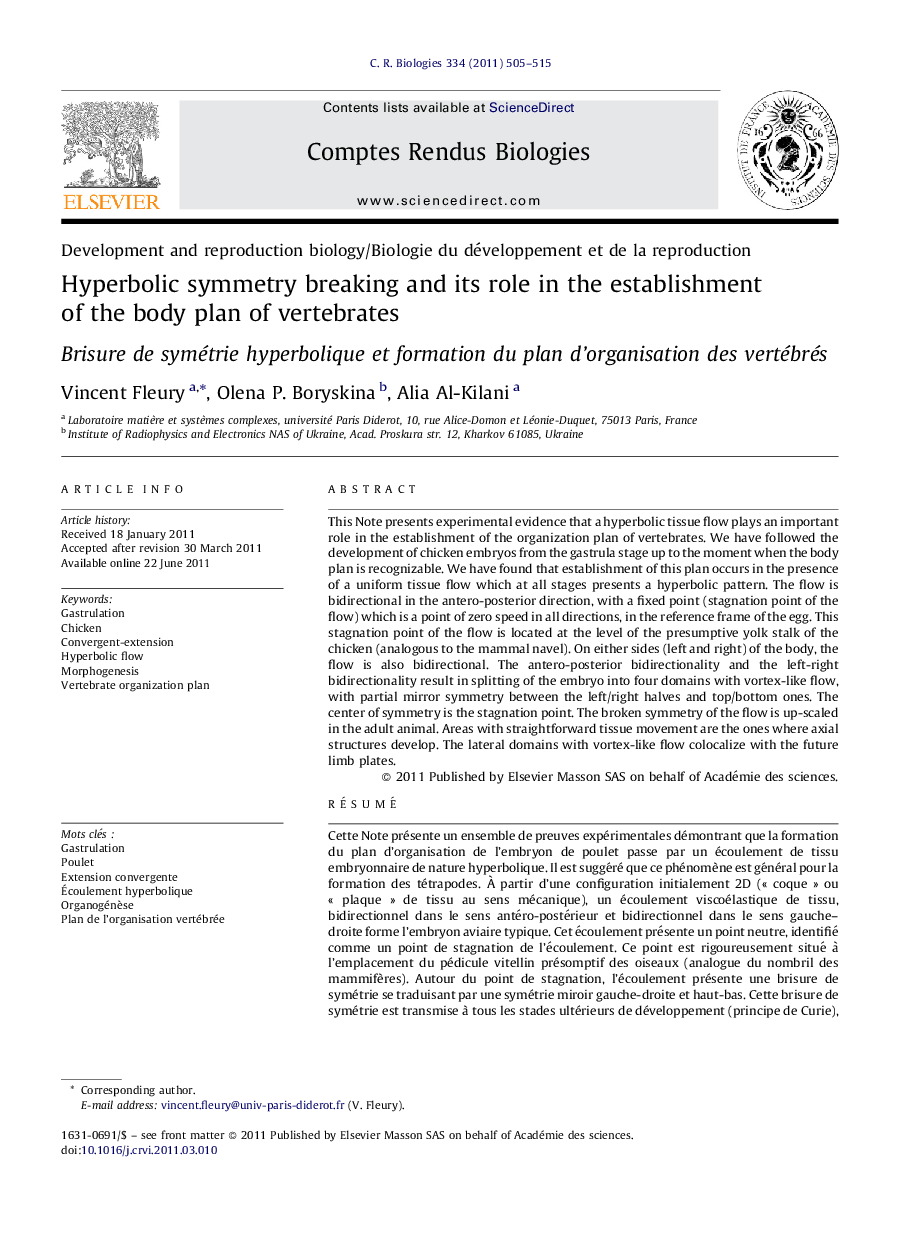| کد مقاله | کد نشریه | سال انتشار | مقاله انگلیسی | نسخه تمام متن |
|---|---|---|---|---|
| 2783949 | 1153784 | 2011 | 11 صفحه PDF | دانلود رایگان |

This Note presents experimental evidence that a hyperbolic tissue flow plays an important role in the establishment of the organization plan of vertebrates. We have followed the development of chicken embryos from the gastrula stage up to the moment when the body plan is recognizable. We have found that establishment of this plan occurs in the presence of a uniform tissue flow which at all stages presents a hyperbolic pattern. The flow is bidirectional in the antero-posterior direction, with a fixed point (stagnation point of the flow) which is a point of zero speed in all directions, in the reference frame of the egg. This stagnation point of the flow is located at the level of the presumptive yolk stalk of the chicken (analogous to the mammal navel). On either sides (left and right) of the body, the flow is also bidirectional. The antero-posterior bidirectionality and the left-right bidirectionality result in splitting of the embryo into four domains with vortex-like flow, with partial mirror symmetry between the left/right halves and top/bottom ones. The center of symmetry is the stagnation point. The broken symmetry of the flow is up-scaled in the adult animal. Areas with straightforward tissue movement are the ones where axial structures develop. The lateral domains with vortex-like flow colocalize with the future limb plates.
RésuméCette Note présente un ensemble de preuves expérimentales démontrant que la formation du plan d’organisation de l’embryon de poulet passe par un écoulement de tissu embryonnaire de nature hyperbolique. Il est suggéré que ce phénomène est général pour la formation des tétrapodes. À partir d’une configuration initialement 2D (« coque » ou « plaque » de tissu au sens mécanique), un écoulement viscoélastique de tissu, bidirectionnel dans le sens antéro-postérieur et bidirectionnel dans le sens gauche–droite forme l’embryon aviaire typique. Cet écoulement présente un point neutre, identifié comme un point de stagnation de l’écoulement. Ce point est rigoureusement situé à l’emplacement du pédicule vitellin présomptif des oiseaux (analogue du nombril des mammifères). Autour du point de stagnation, l’écoulement présente une brisure de symétrie se traduisant par une symétrie miroir gauche-droite et haut-bas. Cette brisure de symétrie est transmise à tous les stades ultérieurs de développement (principe de Curie), et est visible sur l’animal adulte. Le tissu s’applatissant le long de l’axe antéro-postérieur de symétrie forme les parties dorsales (axiales) de l’animal. Les parties s’enroulant suivant quatre cadrans répartis autour du point hyperbolique forment les plaque latérales de l’animal, desquelles émanent les membres. En outre, l’enroulement de l’axe médian par-dessus le plan moyen initial crée la poche abdominale, le cœur et ses connexions aux organes extra-embryonnaires.
Journal: Comptes Rendus Biologies - Volume 334, Issue 7, July 2011, Pages 505–515